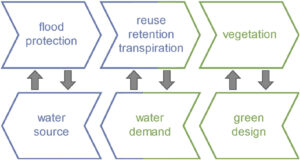
Climate change poses a significant threat to humanity, prompting numerous countries, including India, to implement effective mitigation strategies to alleviate its impact. India is recognized as one of the 17 megadiverse countries, harboring approximately 10% of the world’s known floral and faunal species. This rich biodiversity is largely attributed to its geographical diversity, encompassing coastal plains, deserts, dense forests, and the high-altitude regions of the Himalayas. However, India’s unique geographical features also render its population vulnerable to the adverse effects of climate change, such as extreme weather events, increased energy and fossil fuel demands, and deteriorating air quality, among other climate-related impacts. According to recent reports, India experienced its second hottest season since 1970 during June through August of 2024, with cities such as Thiruvananthapuram, Delhi, Mumbai, and Thane enduring over 70 days of elevated temperatures.
Climate change mitigation strategies for India
In view of this, the Government of India has implemented policies and plans to mitigate climate change in India.
International Solar Alliance (ISA)
In India’s hottest regions, such as Rajasthan and Gujarat, temperatures frequently reach 48 degrees Celsius. These areas are particularly well-suited for hosting one of India’s largest solar farms. Initiated in 2015, the International Solar Alliance (ISA) is a collaborative solar power development project with France. ISA is an alliance of “sunshine countries” aimed at the efficient utilization of solar energy. This alliance was established among countries rich in solar energy resources in order to decrease reliance on non-renewable energy sources, such as fossil fuels.
One Sun, One World, One Grid Project
The One Sun, One World, One Grid (OSOWOG) initiative was introduced at the inaugural assembly of the International Solar Alliance in 2018 and aims to supply energy to approximately 140 countries through a unified grid that facilitates the transfer of solar power. This project serves as a potential solution to numerous global challenges within the energy sector.
Swachh Bharat Mission
The Swachh Bharat Mission represents a significant initiative and encompasses 4,041 statutory towns with the objective of cleaning the streets, roads, and infrastructure across India, while also ensuring the provision of sanitation facilities for every household. As part of this initiative, all villages, districts, and gram panchayats in India declared themselves “open defecation free” by October 2, 2019, coinciding with the 150th birth anniversary of Mahatma Gandhi. The initiative facilitated the construction of over 100 million toilets in rural India.
COP26 Glasgow Summit
At the Glasgow Summit, India pledged to cut emissions to net zero by 2070, outlining a five-pronged “Panchamitra” climate action plan:
- India will achieve a target of net zero emissions by the year 2070.
- By 2030, India will meet 50 percent of its energy requirements from renewable sources.
- India will decrease the total projected carbon emissions by one billion tonnes by 2030.
- India will increase its non-fossil energy capacity to 500 GW by the end of 2030.
- The nation will reduce carbon intensity by more than 45% by 2030.
National Action Plan on Climate Change
This plan aims to raise awareness among the public, government agencies, scientists, industry, and communities about climate change threats and countermeasures.
It is comprised of the following 8 national missions:
- National Solar Mission
- National Mission for Enhanced Energy Efficiency
- National Mission on Sustainable Habitat
- National Water Mission
- National Mission for Sustaining the Himalayan Ecosystem
- National Mission for a Green India
- National Mission for Sustainable Agriculture
- National Mission on Strategic Knowledge for Climate Change
Production-Linked Incentive (PLI) Scheme
The Production Linked Incentive (PLI) Scheme is crucial for India’s efforts in decarbonization, as it encourages the domestic production of green technologies, such as solar panels and electric vehicles. This initiative reduces reliance on imports, enhances energy security, and decreases carbon emissions, while simultaneously promoting job creation and innovation.
Pradhan Mantri Kisan Urja Suraksha Evam Utthan Mahabhiyaan (PM-KUSUM)
This scheme offers subsidies to farmers for installing solar irrigation pumps. The primary objective of the PM KUSUM Scheme is to make cutting-edge technology available to our farmers and provide sources for de-dieselized irrigation to the agricultural sector.
Green Hydrogen Production
India is focusing on hydrogen as a critical element for decarbonizing energy-intensive industries and transportation systems. Under the National Green Hydrogen Mission, India aspires to become a global hub for green hydrogen production, usage, and export, although this initiative is still in its nascent stages.
Carbon Credit Market
The government has taken steps to broaden the carbon credit market by allowing companies that are not required to participate to join carbon reduction initiatives voluntarily, thereby improving the overall management of emissions.
Promotion of Electric Vehicles (EVs)
To make electric vehicles economically feasible, the Government of India (GOI) has implemented a Battery Swapping Policy along with a production-linked incentive (PLI) scheme for Advanced Chemistry Cells (ACC). These initiatives aim to lower battery costs, which account for approximately 40% of total vehicle expenses.
Carbon Sequestration Efforts
The Ministry of Environment, Forest and Climate Change (MoEFCC) intends to boost carbon capture through natural means by creating up to 1,000 urban forests, known as Nagar Vans, throughout India as part of the Nagar Van Yojana. Launched in 2020, this initiative aims to increase urban greenery to enhance quality of life and foster social unity in cities. The focus is on biodiversity, with the planting of fruit-bearing, medicinal, and native plants to attract wildlife and maintain an ecological balance. Community involvement is crucial, offering opportunities for public participation through tree planting, education, and sustainable management practices. Currently, the goal of Nagar Van Yojana is to establish 1,000 Nagar Vans by 2027, supported financially by the National Fund of the National Compensatory Afforestation Management and Planning Authority (National CAMPA).
Blue-Green Master Plan of Delhi – Nature Based Solution Strategy

Planning approach of blue-green infrastructure (Well and Ludwig, 2020; CC BY-SA 4.0)
The Blue-Green Master Plan for Delhi represents a crucial effort to boost the sustainability and resilience of the city in the face of climate change. This initiative aims to create versatile blue-green infrastructure that merges water and vegetation components. By integrating these elements, the plan intends to tackle environmental issues such as pollution, water shortages, and a lack of green areas. It highlights the interconnectedness of water bodies and land, fostering a mutually beneficial relationship that provides numerous environmental and social benefits. The plan includes strategies for enhancing water management, green spaces, transportation, energy efficiency, and more, all woven into a comprehensive approach for sustainable urban development.
The road map for India to achieve net zero
India’s path to achieving net-zero emissions necessitates a holistic strategy that includes multiple sectors and stakeholders. By boosting carbon sequestration through reforestation and implementing sustainable farming practices, along with initiatives like the National Mission for Green India (GIM), the country can counterbalance its carbon emissions. Enhancing disaster management frameworks, advancing early warning systems, and investing in climate-resilient infrastructure, such as the National Cyclone Risk Mitigation Project, are crucial for building climate resilience. The promotion of eco-friendly transportation, as demonstrated by the Faster Adoption and Manufacturing of Hybrid and Electric Vehicles (FAME) scheme, is vital for cutting emissions. Meanwhile, climate-smart agricultural methods, including organic farming, agroforestry, and precision agriculture, are supported by the Pradhan Mantri Krishi Sinchayee Yojana (PMKSY). The primary aim of PMKSY is to align irrigation investments at the field level, increase the area under reliable irrigation, enhance on-farm water use efficiency to minimize water wastage, promote precision-irrigation and other water-saving technologies, boost aquifer recharge, and introduce sustainable water conservation practices by assessing the potential of reusing treated municipal wastewater for peri-urban agriculture, while also encouraging more private investment in precision irrigation systems.
Global cooperation is vital for gaining access to clean technologies, obtaining climate funding, and exchanging best practices with other developing countries through initiatives such as the International Solar Alliance. Robust policy backing, infrastructure enhancements, and technological advancements are necessary to enable a shift to a low-carbon economy. The Pradhan Mantri Kisan Samman Nidhi offers financial aid to small and marginal farmers, motivating them to embrace sustainable agricultural practices. This program is designed to meet the financial requirements of all farming families by acquiring various inputs to ensure healthy crops and suitable yields, aligning with the expected farm income and domestic needs.
Conclusion
Combating climate change requires a unified global approach, with countries implementing customized sustainable strategies. India’s target of reaching net-zero emissions by 2070 is challenging, considering its energy requirements and development goals. By harnessing renewable energy, boosting carbon capture, and adopting technological advancements, India can promote green transition. However, achieving this relies on strong policy backing, global cooperation, and substantial investment in sustainable infrastructure and clean technologies. Balancing economic development with environmental stewardship is crucial for a resilient and sustainable future.




